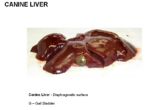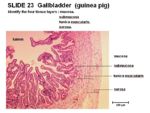Gall Bladder - Anatomy & Physiology
Jump to navigation
Jump to search
BACK TO ALIMENTARY - ANATOMY & PHYSIOLOGY
BACK TO THE LIVER
Introduction
The gall bladder stores bile produced in the liver. Bile is important in the digestion of lipids.
The gall bladder forms as an outgrowth of the bile duct, as a secondary hollow at the posterior edge of the original hepatic rudiment. The gall bladder and the cyctic duct joins the common bile duct which enters the duodenum at the major duodenal papillae (with the pancreatic duct) on the dorsal surface of the duodenum
Structure
- Lies between the right medial and quadrate lobes of the liver
- Partly attached
- Partly free
Function
- Stores bile
- Concentrates bile by absorption through the folded mucosal wall
Innervation
- Parasympathetic nerves
Histology
- Highly folded mucosa
- Reduced submucosa
- No lamina muscularis
- Simple columnar epithelium
- No glands
Species Differences
Equine
- The horse has no gallbladder
Rodents
- Rats do not have a gallbladder
Canine
- In some dogs, the gallbladder is so deeply embedded it makes contact with the diaphragm and contacts the parietal surface
- Lies opposite the 8th intercostal space
- Thinest layers of tunica muscularis
Bovine
- Thickest layers of tunica muscularis
- Sheep have a less projecting gall bladder than cows
- Gallbladder lies against the 10th or 11th rib
- Pigeons and parrots lack a gallbladder

